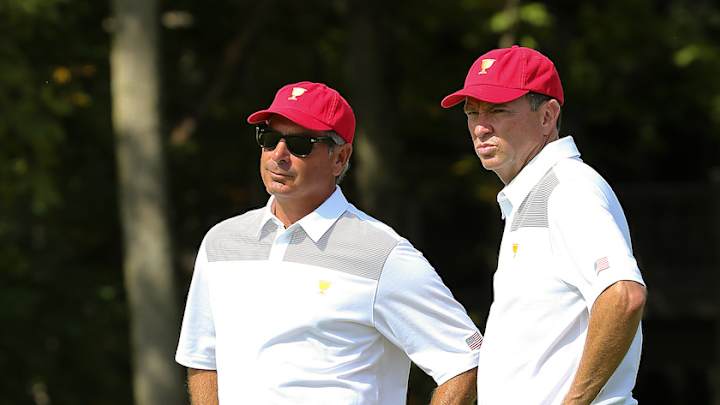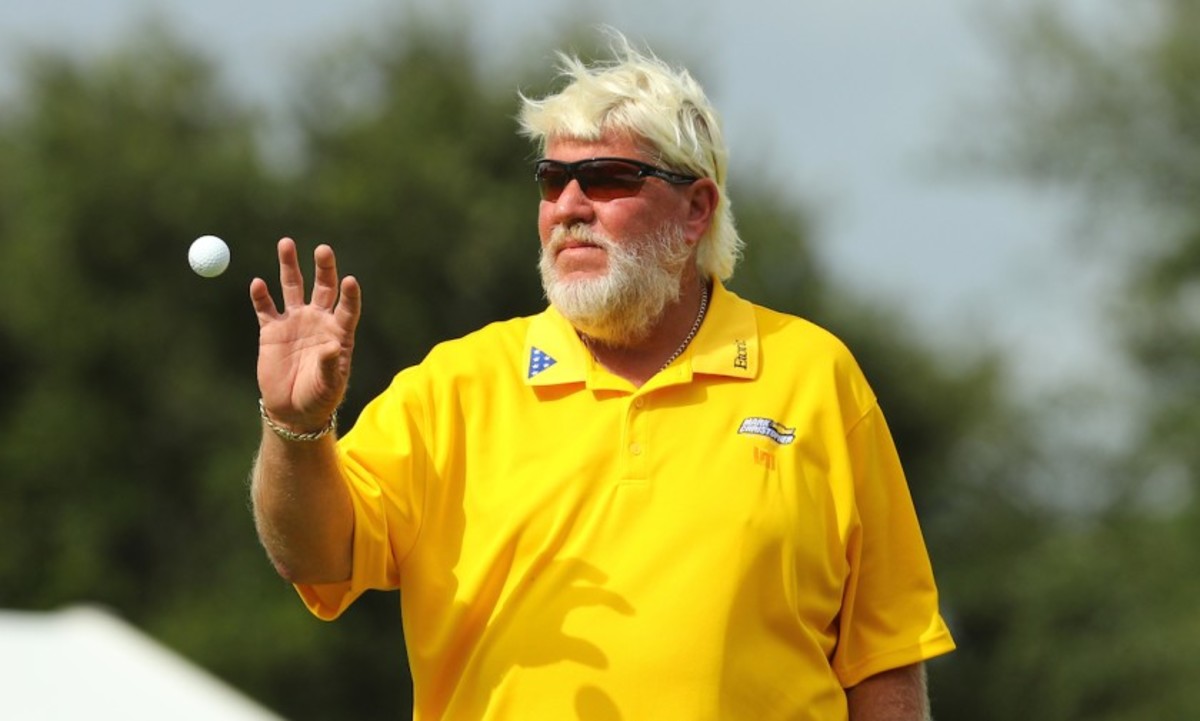What makes a fan favorite on PGA Tour? It’s complicated

Nobody pays money simply to watch guys hit balls with sticks.
The point is, there’s more to professional golf’s success as a spectator sport than meets the eye. I’ve often wondered, what is it about the way one pro hits his ball with a stick that attracts fans more than the way another pro hits his ball with said stick? The media play a big role.
Exhibit A: Payne Stewart wins 11 times on the PGA Tour, including three major championships, compared with Larry Nelson’s 10 wins, of which three were majors. Stewart’s flamboyant wardrobe and narcissistic flair equaled superstar. Nelson’s humble personality and lack of color equaled “Larry Who?” to the public.

Exhibit B: John Daly (five wins, two of which were majors) versus Retief Goosen (33 global victories, including two majors). Daly’s unlikely rampage from ninth alternate to PGA champion in 1991, plus his mullet and voracious beer drinking, equaled folk hero. Goosen won two U.S. Opens, including one snatched from Phil Mickelson, and had a struck-by-lightning tale, but his low-key demeanor and thin media coverage – as with Nelson – never inspired American fans.
At the 1992 Nissan Los Angeles Open at Riviera, Fred Couples and Davis Love III squared off in a playoff in which the gallery was decidedly for Couples. “People were outwardly pulling against me,” a disappointed Love said after losing. Both players were rising stars, big hitters and likable, yet fans chanted, “Fred-DEE! Fred-DEE!”
In golf or tennis or NASCAR, there is no home side to cheer as in team sports. Come for the golf and stay for the personalities. That’s what it is about. Pro golf thrives for the same reasons as reality shows. Viewers develop attachments to certain contestants, dislike others and cheer accordingly. (“The unemployed hairdresser from Kansas is sweet, but that backstabbing waitress from Philly is a little you-know-what!”)
How do such attachments occur in golf? To borrow from noted psycho-analyst Avril Lavigne … it’s complicated. But my hairdresser, who’s a sweetheart, has identified three primary methods.
The Contender Frequency Factor
America can’t fall in love with you, Pro, until they get to know you. So, the more often you get in contention, the more you appear on telecasts and the more the media presents your story.
You can do this by winning multiple times. Keep in mind that three Barbasol Championship victories do not equal even one glamorous PGA Tour title such as the AT&T Pebble Beach Pro-Am, the Players Championship or any stop on the way to the Masters, after which interest starts to wane.
Mark O’Meara didn’t become a household name by capturing the 1984 Greater Milwaukee Open, but he was one after he won the Pebble Beach Pro-Am four times in eight years (and later added a fifth).
How many non-major wins does it take to meet the Contender Frequency Factor (or CFF, as they’ll no doubt dub this one day at M.I.T.) requirement? It depends. Boo Weekley and Bubba Watson needed just one win for audiences to identify with their down-home, folksy characters. Weekley got a lot of mileage out of three PGA Tour wins and a star turn in a Ryder Cup, and Watson won a pair of Masters. Without a major title, the over-under on reaching the CFT for the average I’m-a-guy-who’s-good-at-hitting-balls-with-sticks player is about 9.5. After 10 wins, we know you, Pro, or at least we know the image carefully crafted for you. Close enough.
Majors are more fickle. Some multiple winners such as Nelson and Goosen didn’t get their full measure of respect. Ditto Vijay Singh, who snagged three majors but preferred to keep the media at arm’s length. Brooks Koepka had to win three majors before the public (and the media) warmed to him.
One well-choreographed or popular victory can do the trick, however. Daly, obviously. Adam Scott, the first Australian to win in Augusta. Tim Herron morphed from unknown to household name – “Lumpy” – when he captured a Honda Classic. France’s Jean Van de Velde became an international celebrity for his underdog-disaster tale of blowing the 1999 British Open at Carnoustie.
And there’s the man who retired the trophy – Lee Trevino, a little-known but wisecracking former Marine corporal whose first victory, the 1968 U.S. Open, launched “SuperMex” headlines and a Hall of Fame career. That’s how you make an entrance, Pro, and win fans.
The Appearance Appreciation Factor
The most basic ingredient for fan appeal, Pro, is the AAF (as Harvard Business School scholars surely will tag it): Good looks.
According to the Business Insider website, studies show that good-looking people are more likely to get hired, and they make 12 percent more money than their less-appealing colleagues. Psychologists call it the Beauty Premium. Why should golf be any different?
Tiger Woods and Jack Nicklaus are the greatest players of all-time. As such, no rules apply to them.
But Woods had fashion-model looks and a thousand-watt smile that was as electrifying as his play. Nicklaus dominated the 1960s but was initially unpopular because he dethroned beloved Arnold Palmer, and his crewcut and heavyset physique led to the rude “Fat Jack” nickname. Nicklaus got a total makeover in the early ’70s, growing out his hair, adding sideburns and transforming into someone who looked, indeed, like a beautiful Golden Bear. Oh, and he kept piling up major titles.
Greg Norman was handsome, played aggressively, had the colorful “Shark” moniker and a frequent smile. Women loved him; guys wanted to be him.
In fact, the square root of the AAF is … the smile. Fans like to see someone enjoying the game they love. Most of the all-time popular male golfers had great smiles: Palmer, Trevino, Stewart, Mickelson, Johnny Miller, Seve Ballesteros, Ben Crenshaw, Tony Lema, Tom Weiskopf, Sam Snead, Brandel Chamblee (OK, I slipped him in to check if you’re paying attention.)
Going back to that ’92 L.A. Open playoff with Love, Couples had a better resume (and had won at L.A. two years earlier) but a contributing factor to the one-sided gallery was that Love was old-school and seldom smiled on the course. His typical expression indicated he’d just caught a whiff of bad cheese. It required a lot of wins, a clinching Ryder Cup putt and a PGA Championship title beneath a rainbow for Love truly to catch on with the public.
Mickelson and Matt Kuchar are the lucky beneficiaries of good genes. At rest, their face muscles give the appearance they’re smiling. People see that and assume they’re fun, delightful fellows and for purposes of TV and public relations, perception is reality.
A few decades ago, I helped Johnny Miller write a magazine column in which he thought more players needed to understand that they’re in the entertainment business and should give fans a little more value. It was another good early call by Miller.
The Theatrical Direction Factor
Fans want to feel as if they’re in on the action. That means eye contact, a meaningful wave or a PDE (Public Display of Emotion – high five!) so they can share the moment. Serious players such as Nick Faldo, Vijay Singh or David Duval rarely did those things. Have you ever met a member of the Nick Faldo Fan Club? There’s a reason for that. He played joyless golf, and he was oblivious to fans and players alike.
Palmer was the founder of the modern TDF (as Golf Channel’s Department of Arnold-osophy likely will describe it).
There was the red-visor toss when he won the 1960 U.S. Open at Cherry Hills; grimaces after key missed putts, as if somebody just shot Old Yeller; and the 1962 British Open at Troon, when he burst through the crowd that swarmed the 18th green to witness his win, then put a hand on his back and his knee and limped as if he’d been gravely injured in the chaos, grinning all the while. Arnold Palmer, master thespian!
Woods remains the all-time champion. Nobody did bigger fist pumps more often on the biggest stages. There have been many Oscar-worthy moments by golfing thespians. Fuzzy Zoeller waved the white towel at Norman during the 1984 U.S. Open at Winged Foot. Norman graciously returned the favor the next day and years later, Zoeller used a towel to cool off Norman on the final green of the 1994 Players Championship, in which Norman defeated Zoeller by four strokes. Fans loved both players for it.
Payne Stewart holed the winning putt in the 1999 U.S. Open at Pinehurst and did the arm thrust. Even better, he then pulled expectant dad Phil Mickelson to his face and said, “You’re going to love being a father!”
Negative theatrics have fan-chilling affects. Sergio Garcia spitting into a cup in 2007 at Doral. Patrick Reed shushing an unfriendly Ryder Cup gallery in 2014 at Gleneagles. Bryson DeChambeau berating a cameraman for following him after a muffed bunker shot last year in Detroit.
Dustin Johnson has been prolific winner this century, but he hadn’t connected with the public because of his lack of color. His favorite answers to media questions are, in order: “Yeah … I guess … I don’t know.” He just wins, baby. But when Johnson dominated the Masters in November, he got choked up afterwards. His unexpected emotional display defrosted the media and the public. Johnson now feels like Our Guy.
A simple gesture can cement the public’s affection. Such as Nicklaus putting an arm around Tom Watson after the “Duel in the Sun” in the 1977 British Open at Turnberry and them walking off the green together in a show of respect and sportsmanship.
Still, nothing beats a master thespian in action. Hale Irwin was a bespectacled two-time U.S. Open winner who methodically went about his business. In 1990, at age 45, he got into the U.S. Open on a special exemption, By then, he’d had a Golden Bear-like makeover (contact lenses, for one thing). When he holed a monster putt on the 72nd hole that would force a playoff he’d win the next day, he made an utterly out-of-character victory lap behind the green at Medinah as he smiled and high-fived spectators as he dashed past.
Nobody had ever seen such emotion pour forth from the normally stoic Irwin. That moment, replayed repeatedly on network news stations, changed the way fans viewed the detached Irwin. They thought, Hey, that Hale Irwin guy is all right. I like him!
Until then, they thought he was just really good at hitting a ball with a stick.
Sign up to receive the Morning Read newsletter, along with Where To Golf Next and The Equipment Insider.
